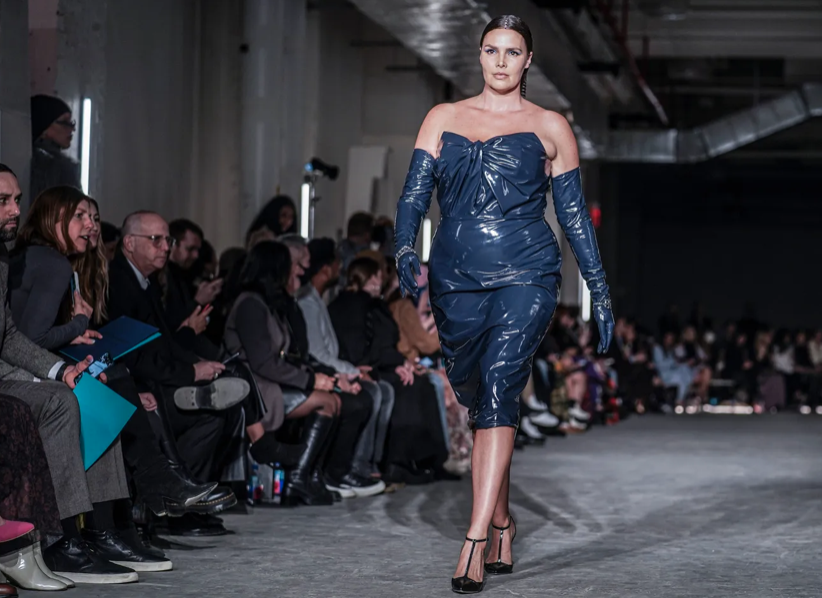A look from Christian Siriano’s NYFW Fall/Winter 2022 collection. Photo courtesy of Bebeto Matthews.
LEAH OLLIE | STAFF REPORTER | lollie@butler.edu
At New York Fashion Week, which happened Feb. 11-16, the most prominent designers in contemporary fashion debuted their Fall 2022 collections under the circumstance of a global pandemic, labor rights reckonings and public calls for diversity and representation. New trend cycles are sure to follow, as well as evaluations of the impact that NYFW maintains on the fashion industry.
Shows from Collina Strada, Tory Burch and Cristian Siriano presented bold silhouettes and vibrant colors, while furthering the lanes of Y2K nostalgia that have dominated fashion for the last year. Plus sized models such as Paloma Elesesser made headlines for their accomplishments and advocacy.
One Miu Miu deconstructed schoolgirl two-piece set reached beyond its runway debut and onto countless spring season outlets and magazine covers, inspiring viral social media attention.
Lillie Michael, a sophomore middle and secondary education major and president of EcoReps — a club promoting environmental justice on campus — uses social media to engage with fashion as designers release new works.
“I follow a ton of fashion designers on social media, and that’s how I’ve kept up with NYFW this year,” Michael said. “I like to look at their clothing, and then it shows me different designers I can follow. That’s how people are getting their brands out there, and it’s become such a big business platform in order to grow.”
A notable presence on many runways this month was sequin designs, in varying shapes and sizes. Critics have expressed concerns about the rapid rollover and environmental impact that comes of cheap plastics such as sequins in fast fashion replicas of runway designs. Sequins are just one example of “fast fashion” trends that promote mass consumption during a brief period of popularity.
When new trends make their way to the floors of fast fashion warehouses, flimsy replicas of designer pieces shortly appear after their debut. As fashion fads are cast aside, the discarded clothing items that mimic them often contribute to landfill pollution as opposed to becoming long lasting wardrobe staples.
Martha Clifford, a sophomore arts administration major and EcoReps executive officer, said that bringing awareness to the pollution fast fashion causes is one of her priorities.
“Trends are moving so fast now, and we have these websites where you can buy really cheap articles of clothing,” Clifford said. “People are just consuming a lot of clothing all the time. Within EcoReps we definitely started to talk about [consumption] even more and we considered doing an event like [the fashion swap] that could really bring awareness to it.”
Camille Weiss, a junior psychology major and member of EcoReps, mindfully considers how to share educational information about sustainability with others.
“I’d also say a big piece of [advocacy] is also the educational aspect,” Weiss said. “If you have those people in your life that either shop all the time or from unethical companies, a lot of times they just don’t know. So [sharing] in a non-accusatory way is really important, by informing them and then giving them other options, because I think anything you can do to help the people around you is fulfilling.”
To engage with new styles, clothing swaps are just one of multiple ways to sustainably shop while limiting mass consumption of new products. Thrifting, upcycling and swapping clothes with a friend are other examples of refreshing one’s wardrobe without contributing to the pollution that mass consumption promotes.
Clifford appreciates the new styles and items that thrifting and sustainable shopping have introduced her to.
“There’s a lot of unused clothes out there, and it’s all about finding them in the right places,” Clifford said. “[Thrifting is] still really cheap in the same way that fast fashion is, but you’re obviously not paying for a new piece of clothing. It’s a piece of clothing that’s been used, but something that I found to be super exciting with thrifting is that it has shaped my style in a way that I wasn’t expecting.”
Thrifting new pieces and upcycling old ones proves that sophisticated style and fresh fashion don’t have to come fresh off of high-end runways or unethical production floors.
The next time you spot a fashion trend you favor, consider incorporating it into your wardrobe in a way that will make both your budget and your planet the happiest.
The following retailers have committed to utilizing ethically and environmentally sustainable production practices or materials: Pact, girl of the earth, Vetta, Baggu, Eclipse, Tentree, Plant Faced Clothing, etiko, Veja, KOTN and CHNGE. Whether streetwear or athleisure are your style of choice, browse the above picks for new sustainable shopping options.



